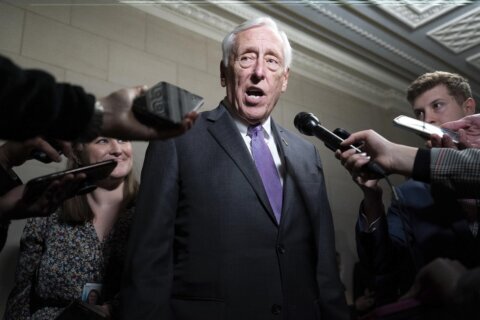This article was republished with permission from WTOP’s news partners at Maryland Matters. Sign up for Maryland Matters’ free email subscription today.
This content was republished with permission from WTOP’s news partners at Maryland Matters. Sign up for Maryland Matters’ free email subscription today.
As more Marylanders returned to work this week, child care providers say they have mounting fears about how their industry will be left to cope with the fallout of the economic shutdown.
When Gov. Lawrence J. Hogan Jr. (R) announced a county-by-county Phase One reopening last week, that didn’t include changes to rules governing child care centers, which are currently limited by a state-funded program for essential workers and strict ratios to enforce physical distancing public health guidelines.
While the Maryland State Department of Education issued guidance last week allowing child care providers to open any available spaces to retail and manufacturing workers who are part of Phase One reopening plans, many of the operating providers have no space to offer, Christina Peusch, executive director of the Maryland State Child Care Association, said this week.
About half of the state’s child care providers were permitted to open in late March, with the state paying weekly rates for the children of essential workers.
The disconnect between more families returning to work in Phase One and the same limited amount of child care was “a foreseeable situation” that state officials should have addressed, Peusch said.
- Sign up for WTOP alerts
- Latest coronavirus test results in DC, Maryland and Virginia
- Virginia Beach to reopen for recreation in late May
- Renewed push for inmate release after coronavirus cases in DC jail climb 25-fold
- Bowser details budget cuts amid pandemic; council to vote on emergency bill
- Some front line workers could get their tolls waived at Dulles Greenway
Looking for more information? D.C., Maryland and Virginia are each releasing more data every day. Visit their official sites here: Virginia | Maryland | D.C.
Kim Ritchey-Headley is the Washington County president for the Maryland State Child Care Association and runs Ritcheys Totlot Child Care Center in Hagerstown.
Her facility has space for 86 children, but is currently limited to serving 34 because of the public health guidelines, which generally limit facilities to 10 people per closed classroom, including teachers, children and other employees.
Ritchey-Headley hasn’t had any openings for new children since the start of the Essential Personnel Child Care Program in March and has 18 families on a waiting list.
With more businesses opening in Washington County, her old families want to resume care. And more families who qualify for the state’s essential worker program ― but initially chose not to participate because a nonessential spouse was home from work ― are also looking for space.
“We still cannot place the essential families from the very beginning,” Ritchey-Headley said.
She’s been working to find placements for one mother since March and recently wrote a letter to her employer about the lack of available child care, as the woman considers taking extended leave from work to care for her children.
“They have no child care. We’re not doing what we need to do out here,” Ritchey-Headley said.
After the lifting of the stay-at-home order in some parts of the state on Friday, Ritchey-Headley is now faced with telling the families who have come to her center for years that there’s no space for them — now, and possibly into the future.
“We’re really hitting these kids hard with their social emotional development, because we’re causing them trauma,” Ritchey-Headley said.
Peusch said child care providers need comprehensive guidance from the state as quickly as possible ― and before Phase Two of a reopening plan ― to help ease access issues.
The Maryland State Department of Education and Hogan’s office did not respond to several questions about child care reopening plans emailed by Maryland Matters on Monday.
The education department issued a brief statement Monday evening:
“MSDE has formed a stakeholder group, and as the Governor announced last week, MSDE will release a child care recovery plan in the near future. The safety and health of children and providers remain the first priority. We are grateful to all of our child care providers, who will continue to play a critical role in the State’s overall pandemic recovery efforts.”
Among other suggestions, Peusch said the state should consider raising the current occupancy limits and allowing centers to modify their open-room floor plans to create more enclosed spaces.
Danielle Lofland owns and operates Pasadena Child Care and Homework Center in Anne Arundel County.
Even though the facility is 6,800-square-feet, Lofland would be limited to providing care there for 10 children because of the open layout, she said.
She’s trying to come up with some plan to reopen the facility in June.
“We’re worried if we don’t go forward, we will go bankrupt,” Lofland said.
More returning to work
The families Lofland used to care for keep reaching out to find more information about reopening.
“It’s heart wrenching as a business owner, as a mom, because they trusted me to be able to provide care that I can’t provide,” she said.
Across the Chesapeake Bay, Lofland also operates Stepping Stone Children’s Center on Kent Island. That facility is licensed to serve 231 children and Lofland initially opened it with 98 spaces for essential workers’ children in March. But after a delay in the state paying invoices for the essential worker program, she closed down.
“Not because we didn’t have families, but because I couldn’t wait five weeks to be compensated,” Lofland said.
There were 50 students in her care when she closed. Six families were able to find other child care center providers through the essential worker program. For many of the rest, Lofland’s former employees are working as babysitters in the family homes to provide care, she said.
It’s a decision that means essential workers are forgoing the state government’s voucher program that was covering the cost of their care.
Paige Stewart is one of them. Her twins ― due to turn two next month ― now receive care at home from one of Lofland’s employees while she and her husband report to work in the business park where Stepping Stones is located.
Stewart, who is a logistics manager for a government contractor providing personal protective equipment, said she opted to pay for in-home care on her own after the only openings at child care centers were far out of the way.
“It’s been very tough to find child care for essential employees,” Stewart said.
Now, with Queen Anne’s and every other Eastern Shore county opening under Phase One guidelines, Stewart’s employees are concerned about their spouses going back to work.
“I have a lot of young parents working for me,” Stewart said. “They’re coming to me and saying they don’t know what to do.”
Increased costs, unregulated care?
Child care providers also expressed concern that reopening with lower capacities will force them to raise prices.
Holly Frazer owns two of the nine child care centers currently open in Washington County. She’s caring for 72 children between the facilities, where she used to serve 145.
She fields three or four calls a day from people looking for child care openings, Frazer said.
If the state’s essential worker voucher program ends and there are still strict caps on capacity, Frazer said she’ll have to dramatically raise rates to make ends meet. Before the pandemic, she charged $170 a week for two-year-old care; if she has to operate with a lower capacity, that could skyrocket to $306. Rates for other children would increase by more than $90 a week, she said.
“There is absolutely no way that Washington County families can pay those rates,” Frazer said.
If the state funds grants to subsidize child care providers that need support, the diminished capacity may not threaten programs’ ability to survive, Peusch said.
“If you do nothing, you will see a proliferation of unlicensed child care,” Peusch said. “You’re going to see a lot more children who are not ready for kindergarten. It can be unsafe, you’re going to see more accidents and incidents.”







